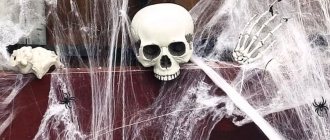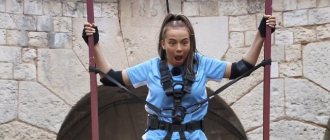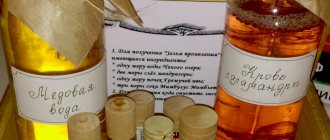We will, of course, be talking about quests that you want to conduct yourself at home, in a classroom, children's club, in the country, etc. For professional quests, all props and decorations are made to order.
All of these products in stores are most often sold in the “Halloween” section. I myself don’t like this holiday, I never celebrate, I don’t come up with ideas for the site for the date, but I always look at selections of accessories and decorative elements with pleasure.
The fact is that even a simple quest with tasks printed on a printer turns into a spectacular action against the backdrop of cobwebs with spiders, giant black rats half the size of a child, and comically creepy ghosts made of different materials. It was for children's and teenage quests with a mysterious plot that all this wealth seemed very appropriate to me. By the way, you can decorate your apartment when you use my free script about an abandoned bunker. He himself is not scary, but the surroundings will definitely add glamor to a home event.
Webs with spiders
In the description of the web, see how many square meters it can be spread. For example, a very small lump weighing 60 g will stretch over 10 sq.m. There are more dense webs, and there are weightless ones. Considering the area of decoration, the cost is not very high. There is no need to stretch it evenly, since the disgusting effect we need is precisely achieved by the type of canvas, which in some places is transparent, in others dirty green, gray or yellow.
Often, one or more spiders are attached to the webs, but you can buy additional plastic evil spirits and hang them on the web in the places you need. To enhance the effect, darken the room and place several flashlights with a weak glow on the floor and various surfaces. If there is a holiday in the apartment, close the window with thick curtains, stretch a web between cabinets, cornices and chandeliers, and decorate the corners. Arrange the lanterns so that the web is illuminated from different angles (on sofas, shelves, on the floor). If there are no colored flashlights, cover the glass with a colored film on which zigzags and streaks have been previously applied using a dark felt-tip pen.
Include a moment in the plot in which children will need to push apart the web with their hands (to do this, place it in layers over a chest or artifact).
Here are all sorts of cobwebs (different colors and sizes) that will inspire you to prepare a scary quest. Tarantulas, small spiders and an assortment of nasty insects are also there.
Detailed description of the quest
A scary quest scenario for adults at home or in the office will allow you to organize a terribly scary and at the same time very exciting search for gifts (surprises) for your family, friends or work colleagues.
♦ Age category of the participant: from 18 years. ♦ Target audience: for female and male audiences. ♦ Travel time: up to 40 minutes. ♦ Purpose of the quest: 1. searching for a gift in a house for adults - having solved all the horror tasks, the participant(s) will find a cache in which the quest organizer knowingly hid the prepared gift (surprise). 2 . searching for a gift in the office - solving one terrible task after another, each time finding a secret hiding place within the office or office, your brave work colleagues will be able to find the main secret place in which trophies (gifts) will be stored. A horror quest for adults is perfect as entertainment or a congratulations on Halloween, and also if your family, friends, or work colleagues love horror stories, thrills, and are connoisseurs of creepy and frightening stories. ♦ Venue: indoor quest - house, apartment, cottage, office. ♦ Number of participants: unlimited (1 or more). ♦ Tasks: All tasks are completely ready for the quest. All you have to do is choose the most suitable places - hiding places for your home or office and print out cards with tasks. The quest consists of 10 task cards and 10 hiding places, respectively. ♦ Quest genre: horror quest for adults with a search for a gift. ♦ Hiding places in the quest: ◊ Mirror ◊ Socket ◊ Plate ◊ Newspaper ◊ Door ◊ Bucket ◊ Where it’s cold (refrigerator) ◊ Heel (shoes) ◊ Bottle (with water or alcoholic drink) ◊ Black bag ♦ Necessary props: pencil or pen to fill in the answers. ♦ The finished quest kit includes three PDF files : 1 . The file “Instructions for the quest” contains a detailed list of necessary actions to prepare the quest for implementation. 2 . The “Quest” file contains all the cards with tasks that participants will need to solve 3. The “Quest with answers” file contains the entire list of tasks with detailed answers. These files will need to be printed on a black and white or color printer. ♦ Other quests on the site: ⇒ Quests up to 10 years old ⇒ Quests up to 16 years old ⇒ Quests from 18 years old
The bats
Almost realistic ordinary mice are also available in sets in many Halloween stores. We put them in boxes and jars with artifacts. But plastic bats are good for entourage and decorating a photo zone for a holiday in the style of a “Horror Movie” or a scary quest.
Don't forget about the lighting options. Even a small LED attached to the figure can turn a plastic toy into a real monster.
Bats, spiders and all kinds of evil spirits are here.
How to create tension in horror games. Part one
Tension, stress and suspense are the 3 pillars of a horror game. The best games in this genre slowly build up the intensity of the game and then release the tension in stages. To some extent, this is what creates the effect of extreme involvement: when the player is so involved in the game that he experiences physical stress.
Good horror games always have a well-thought-out suspense that goes much deeper than low-brow haunted house-style scares. The goal of horror design is to maximize player engagement and emotional impact. But keep in mind: the best games in the genre use the immersive effect of horror content only to communicate more closely with the player. Horror games have the ability to explore themes that no other genre can. The point is not to simply scare the player, but to make them receptive to what you want to convey to them.
Of course, much of the scary content in games is not a product of game design, but rather of storytelling. The setting, atmosphere and characters are the foundation needed to hook the player and send shivers down his spine. But games also have other tools, such as game mechanics and player interaction. The problem of creating fear in a game is not limited to just narrative: it affects every aspect of game design. This is why creating tension in games is a very challenging and interesting task for designers.
This article is dedicated to the mechanics of horror games. It's not about plot or narrative, but about the design of the game systems needed to make the game more dynamic. You can think of this article as sort of an overview of all the patterns we experimented with during the development of our mystery/horror game called Dead Secret, which came out last October for Gear VR and will be coming soon to Steam and PlayStation. This is not a guide to horror game design, but rather a list of ideas for using game mechanics to create tension in a game.
The main goal of all the patterns below is to involve the user in the gameplay so much that he forgets about everything around him. Thomas Grip, designer of games such as Amnesia: The Dark Descent and SOMA, calls the state of complete immersion in a game a “feeling of presence.” These patterns are also necessary to keep the player off balance at all times. Game mechanics are often based on the player recognizing a repeating pattern.
They have a similar structure and are easily recognized. This is convenient because it allows you to develop a habit. If you want to scare the player, you need to make him believe that he is not in control of the situation, that the rules can change at any time, and that he is not able to fully comprehend everything that happens within the game world. Horror games must maintain a delicate balance of vulnerability and helplessness, but not allow the feeling of complete confusion and confusion.
As a horror game designer, it is very important for you to focus the player's attention on the narrative context of the game, and not on its mechanics. You want the player to identify with their character in the game, rather than act as an independent individual completing tasks in a game-like manner. Many of the ideas presented here are aimed at changing the player's mindset from a systemic way of solving problems (analyzing statistics, min/max indicators, thinking about design patterns or tactics) to a contextual one ("Who sent this hint?" or "How get out of here?"). Some of these patterns are not entirely suitable for other game genres, since they do not allow the player to calculate the game like a Rubik's cube. But solving a Rubik's cube is not as scary as, say, deciding which ancient artifact is best suited as a weapon against the One Who Has Many Names. One way to create a sense of ownership in the game's content is to make losing meaningful to both the player and the character. Game Over usually means the death of a character, but how do you make the player feel the loss too?
This is usually achieved by placing save points at certain intervals so that if the character dies, the player loses all game progress. This works effectively, especially if the save points themselves are interesting (see the save point system in Alien: Isolation). But the concept of save points itself has long gone out of fashion. Dark Souls, for example, uses a more modern system of creating tension in the game through the fear of losing progress.
Another option is to make the loss itself stressful. In indie horror games like Five Nights at Freddy's and Slender, if you fail, all sorts of scary creatures will jump out at you. We chose the latter option for Dead Secret to allow for the ability to save anywhere in the game. This model uses the fear of a sudden event to make the player nervous at the thought of failure.
By hiding the various numbers and indicators that accompany the game from the player, you encourage him to think more contextually. “How much health do I have left? Can the enemy see me? Am I going in the right direction? How many shots does it take to defeat this boss? In any other genre, giving players access to all this data is considered good form. But in horror games, it's best to only provide information through some kind of contextual abstraction.
For example, the games Resident Evil and Silent Hill have traditionally used very rough categories to display health levels (Fine, Caution, Danger) - even though under the hood the same calculations are made in the same way as in any other game. game. In addition, Resident Evil uses animations to indicate health levels: you may not know for sure how soon you will die, but when your character is hunched over holding his stomach, things are clearly bad.
By hiding information and rules of the game, you do not leave the user the opportunity to find safe paths and use a minimax strategy. This also introduces some uncertainty into the game. When the user is not completely sure of how the system works, he is forced to rely on the environment and story to make decisions.
In Dead Secret, I tried to achieve the effect of uncertainty by abandoning the principle of the “safe zone”. In other words, there is not a single place in the game where the player could feel completely safe: an insidious enemy in a hood and with a But mask on his face can lie in wait for you anywhere and deal a fatal blow. At least that's what I would like our players to believe.
There is some significant medical research suggesting that people are more likely to experience fear when they are in a state of physiological arousal. In psychology, this phenomenon is called arousal misattribution. To do this, the player must be in a state where his pulse quickens, adrenaline is released into his blood, and he begins to sweat. If we add scary game content to all this, the user becomes predisposed to “false” emotions: there is a possibility that the brain will react incorrectly to the stimulus, as a result of which the player will actually get scared.
Misattribution is a very powerful form of emotional control. But it has one important caveat: it only works when the subject is not aware that he is in a state of arousal. Psychologists proved this with one experiment: they selectively injected subjects with adrenaline, and as a result, they were able to induce false emotions only in cases where the subjects were unaware of the injections. It turns out that you, as a designer, need to pump up the player so that he doesn’t even understand it.
Stimulus:
a menacing grizzly bear is approaching
Excitement
: rapid heartbeat, trembling, sweating, running away
Cognitive label:
“What a scary bear!
I'm afraid of him!" Emotion:
Fear
Schechter-Singer's two-factor theory of emotion states that emotions arise from physiological arousal and the contextual interpretation of that arousal. Misattribution can occur when our brain uses a ready-made context to justify our physiological arousal.
Typically, complex and unpredictable gaming systems are used to subtly lead the user into a state of physiological arousal. This can be a brutal and difficult combat system, like in the game Condemned, where even the lowest level enemy can kill the player if he hesitates. Or, for example, a constant lack of resources and inconvenient controls, as in Resident Evil, where any meeting with an enemy turns into a serious test. And in Siren the player is so weak that any battle also risks being the last.
A challenging physical activity like some hardcore button fighting is also great. However, sometimes this option takes on the most unexpected forms. For example, Night of Sacrifice, a rather mediocre haunted house game, seems scarier than it actually is because it requires the player to walk using the Wii Balance Board, which increases the heart rate.
Next time you're playing a challenging game, stop for a moment and check if your palms are damp. Ask yourself if you were squeezing the joystick a little harder than you should have? Does your heart fly out? If so, it is likely that in this state everything that happens on the screen seems more impressive to you than in reality.
Paper garlands for a scary photo zone
Paper garlands aren't that scary, to be honest. More like creepy and humorous. For some purposes, bones with skulls alternating on threads, bats, spiders, funny skeletons, etc., are quite suitable. The idea is more suitable for decorating a photo zone. Thematic elements can be supplemented with paper honeycomb balls, forfeits and tassels in the desired color. Black, gray and blood red, for example. There are also ready-made sets of Halloween balls, which are often used to decorate a birthday party with a scary quest.
Realism
If your goal is to provide maximum immersion for players, then the most sophisticated and unusual ways of interacting with players are used. For example, in one of the Moscow quests, bags with a terrible smell of urine are placed over the players’ heads. In the kitchen you can find a pile of rotten meat, which is decomposing and creates an incredible stench.
Sometimes, in order for a person to believe in the reality of what is happening, one must personally erase this line and cross certain boundaries. Then, even for fifteen, even for five minutes, he will be completely immersed in your world and literally merge with it. And when this happens, you can be sure that he will be in a positive shock.
Banners and portraits of creepy characters
I liked the large finished pictures. There are banners and thematic posters in human size. For example, a creepy mirror that reflects something from the other world. Or a “crack” in the wall, in the depths of which skeletons are visible. Isn't it creepy? There are also sets with portraits of vampires and other unsympathetic personalities. Some of them are attached as temporary stickers, others need to be attached with double-sided tape. The main thing is that in a few minutes you will create in any room a branch of an ancient house in which strange events have been taking place for 500 years.
I posted a really creepy one in the photo; there are calmer and nicer horror banners. Banners in the form of windows, behind which silhouettes of monsters are visible, look especially impressive.
Quest plot
The horror quest for adults begins with the participant(s) finding an envelope from Jack Pumpkinhead. In their letter, various monsters address the quest participants with a desire to have fun and have fun. Each such monster prepared its own horror story - a terrible task. The following monsters participate in the quest: Count Dracula, Skeleton, Frankenstein, Mummy, Chucky Doll, Zombie, Werewolf, Witch, Ghost, Grim Reaper. All this evil spirit will frighten the participants so that they will under no circumstances solve their task and thus fulfill the terms of the deal with the dark forces. ♦ Text of the letter: “Ehh, how good it is to be back in the world of the living! After all, only here you can enjoy something tasty. And in the world of the dead, our terrible team can only taste the carrion. Anyway. Jack Pumpkinhead said that you really love scary and gruesome stories! Here is one of them. Each of the scarecrows will give you one task, if you are not scared and unravel all our secrets, you will receive a gift from us. If not, we’ll drink your blood, bite off the head, gnaw off your arms, break your legs, fry your heart, and boil your body.” Along with the monster letter, participants will find the first task card. ♦ Completion of the quest: After the participants solve all the scary tasks and find all the hiding places, a trophy (celebratory surprise) will be waiting for them in the last secret location.
Skulls and bones
There is quite a lot of this goodness in stores. There are entire string bags with sets of almost life-size skulls. There are garlands (chains) with small skulls, skeletons and bones. All this can be used to design a photo zone and create an ambience for the place. For example, pour sand into the box, lightly riveting the skulls and sprinkling the bones. Let the necessary artifact also be in this box.
There was something similar in the scenario of the quest about Robinson.
Imagine that a slime with a key needed for the game is inserted into the jaw... Children need to get an artifact from this slime. Ugh…
Fashion for horror quests
Running a quest in reality in the horror genre is somewhat easier than any other quest. The main emphasis here is on simple puzzles, a variety of effects, the participation of the actor, and, of course, props and lighting. In the regions, the minimum investment threshold can start from 200 thousand for the entire quest, and together with a high-quality script, it can actively exist for quite a long time and generate profit. We have a couple of cases where such a quest paid for itself in a few months and then worked as a good plus.
It's better to go in a male group
I continue to test my nerves on all sorts of quests, and this time I came across “The Thing” - a purely male pleasure with wheels, girls and hell. On the advice of one experienced person, we took the premium version and went to the game exclusively with a same-sex group: me and my friends Andrey, Artem and Vlad. You will soon understand why this composition is much preferable. We could only guess about it, but the age limit of 21 hinted at various forbidden joys from the threshold.
The beginning is standard: instructions, choice of difficulty mode, etc. But suddenly you are surprised by a strange requirement: you must take off the crosses, and at that moment I even regretted a little that I didn’t have one. While I was blinking, everyone was taking them off as if they were handing over their last weapon. Then the most interesting thing began: we were given an unknown pill and asked to swallow it “in order for the quest to begin” (this concept was more or less clear to us). Just before the start, the organizers announced that the pills have a side effect: it may seem like hours or days have passed, although only seconds have passed (I’ve heard about this somewhere before!). But the main thing is: we will all end up in the fantasies of one of us!









